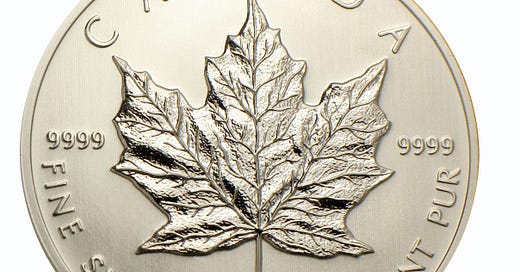I have a lot of exposure to silver. BHS.V, ELO.T, BIG.V, CFE.C, CCMI.V and GRSL.V all are primarily silver plays or have a large silver component. (I even have a few one ounce “Maples” pictured above). So I pay attention to the price of silver and, as I pointed out a couple of days ago, the new “base price” for silver seems to be $30.00 an ounce. But is that even close to the actual price of physical silver?
There are, effectively, two markets for silver. The market for physical silver actually delivered and the market for silver futures contracts which are, in theory, backed with physical silver but, in practice tend to be settled for dollars rather than ounces.
For years there was no effective way to determine the real price of silver. You could look at the premiums charged by coin dealers for some indication. For example, my own dealer, Victoria Old and Gold, sells one ounce coins with a premium of $5.55 in smaller quantities and 1000 ounce bars with a premium of $2.10 per ounce (all figures in Canadian dollars). However, a lot of that premium is really a retail mark-up rather than a reflection of the “real” price of silver.
A better metric is the price of silver in Shanghai. Demand for silver has increased greatly because of its use in solar panels. China manufactures about 90% of the world’s solar panel supply and this is reflected in the Shanghai price. What is also reflected in that price are the Shanghai market rules. These are a bit tricky but they come down to this: to write a futures contract for delivery a trader must have the physical silver the contract represents in a registered vault. In effect, this limits the number of futures contracts which can be written and means that the Shanghai silver price is a much better reflection of the real price of silver.
As I write the Shanghai price of a kilogram of silver is USD $1151, the New York spot price is USD $1034 per kilogram. $117/kilo delta or $3.34 an ounce.
The effect of this differential is to suck physical silver towards the manufacturers in China. Bloomberg recently reported that China's silver imports hit a three-year high of 390 tons in December and 340 tons in April — above the five-year monthly average of 310 tons.
The biggest difference between the market for gold and the market for silver is the fact that the silver market is driven by real, industrial, demand for a commodity whose worldwide production has consistently fallen below worldwide demand.
Silver bulls are a tenacious lot with long memories stretching back to the Hunt brothers’ attempt in the late 1970’s to corner the silver market driving prices from $1.50 an ounce to $50.00 before crashing in 1980. Silver bulls also like to point to 2011 when silver hit $44.40 an ounce before falling back to $13.92 by 2015. These runs are usually referred to as “excursions” by the silver investing community.
Excursions in the silver market are great fun if you happen to hold physical silver or shares in a silver producer. But they are also huge opportunities for junior silver explorers and development companies. When silver takes off, the general investment community starts paying attention to silver companies. Just having “silver” in a company name can lead to 5-10x share price appreciation. The old “fear of missing out” syndrome strikes and the fact many junior silver companies trade for pennies makes them all the more attractive.
The obvious question, as silver flirts with $32 an ounce spot and nearly $33 in Shanghai, is are we at the beginning of an “excursion”? If you want to read material from raging silver bulls, look no further than the very well done Silverseek.com. (For pure hype check out #silversqueeze on Twitter.)
While I would welcome an excursion, I am a bit less bullish. Prior excursions have been driven by market manias and a surge of retail investors trying to catch the rocket. That may happen again and it may happen quite soon, but a surer bet is that supply/demand fundamentals are resulting in a powerful, but not yet parabolic, surge in the price of physical silver. Not as exciting as an excursion, but more sustainable.
Which is very good news for junior explorers and developers. As I mentioned earlier in the week, the entire 43-101 process requires juniors to make commodity price “guesses” based on the values at the time the MRE or PEA is released.
For example, Bayhorse Silver released a 43-101 compliant Inferred Mineral Resource Estimate in 2018 for its Bayhorse mine in Oregon its consultant said,
APEX Geoscience Ltd., used a silver cut-off grade of 7.5 opt Ag, based upon a conceptual overall mining and processing cost of $US100 per ton, a silver price of US$15/oz at US$/C$ Exchange rate of 0.7624/1.3117 and an assumed recovery of 90%.
The silver surge has overtaken that “guess”. The BHS share price, on the other hand, has not. The 6.3 million ounces are still there, mining and processing costs have certainly gone up, but they have not doubled.
(You can imagine the economic impact of $32 silver on Eloro’s Iska Iska project in Bolivia where there are 298 million ounces Ag and counting.)
The surge in the silver price has improved the economics of every one of my silver holdings. An improvement which has not been reflected in their share prices…yet.
[Disclaimer: I hold positions in BHS.V, ELO.V, BIG.V, CFE.C, CCMI.V and GRSL.V which I may add to or sell at any time. This is not investment advice. Do your own due diligence. Call the CEO.]




LOL...happens to the best of us.
As I write the Shanghai price of a kilogram of silver is USD $1151, the New York spot price is USD $1034 per kilogram. $117/kilo delta or $3.34 an ounce.
$33.40 an ounce?